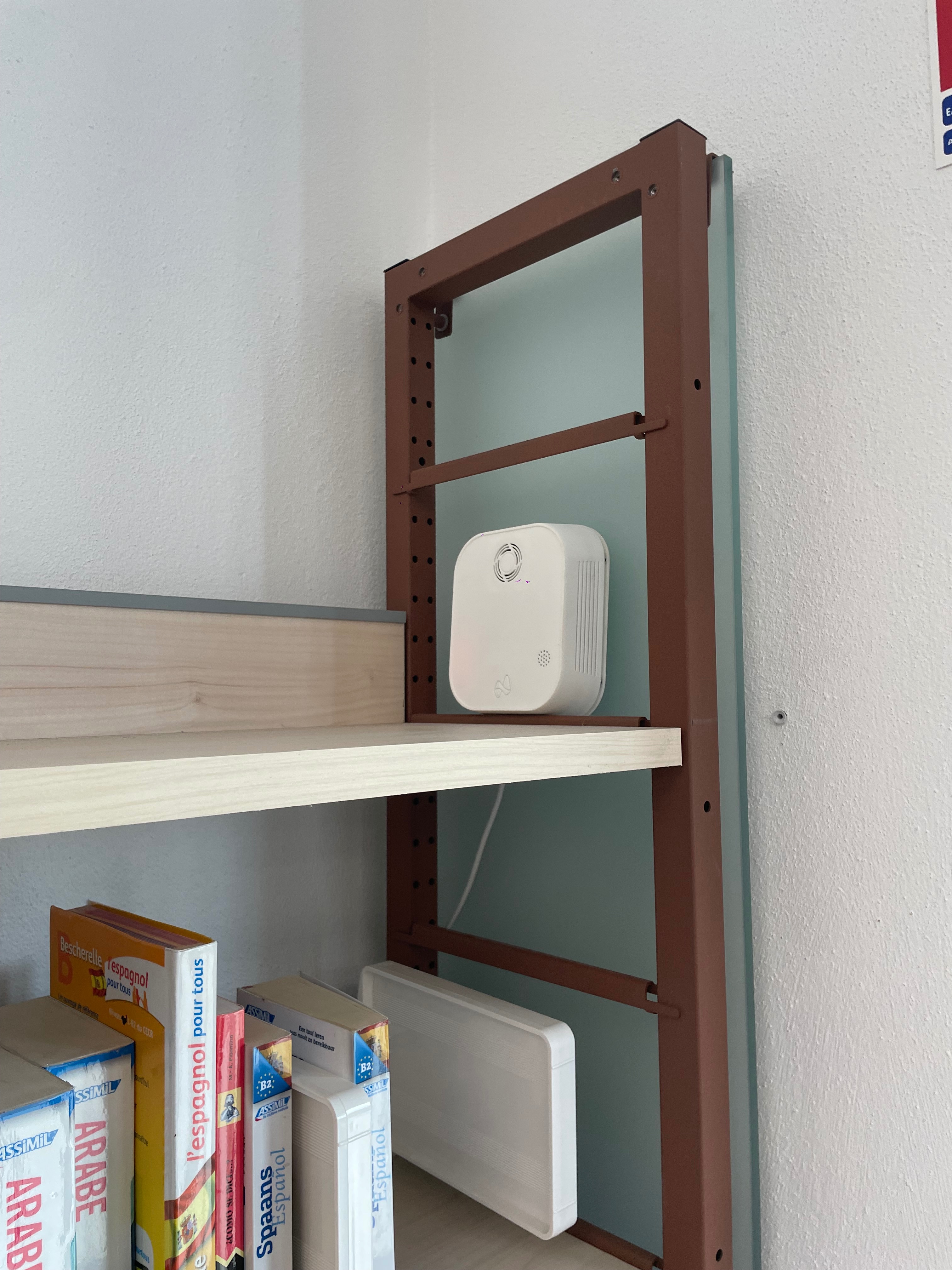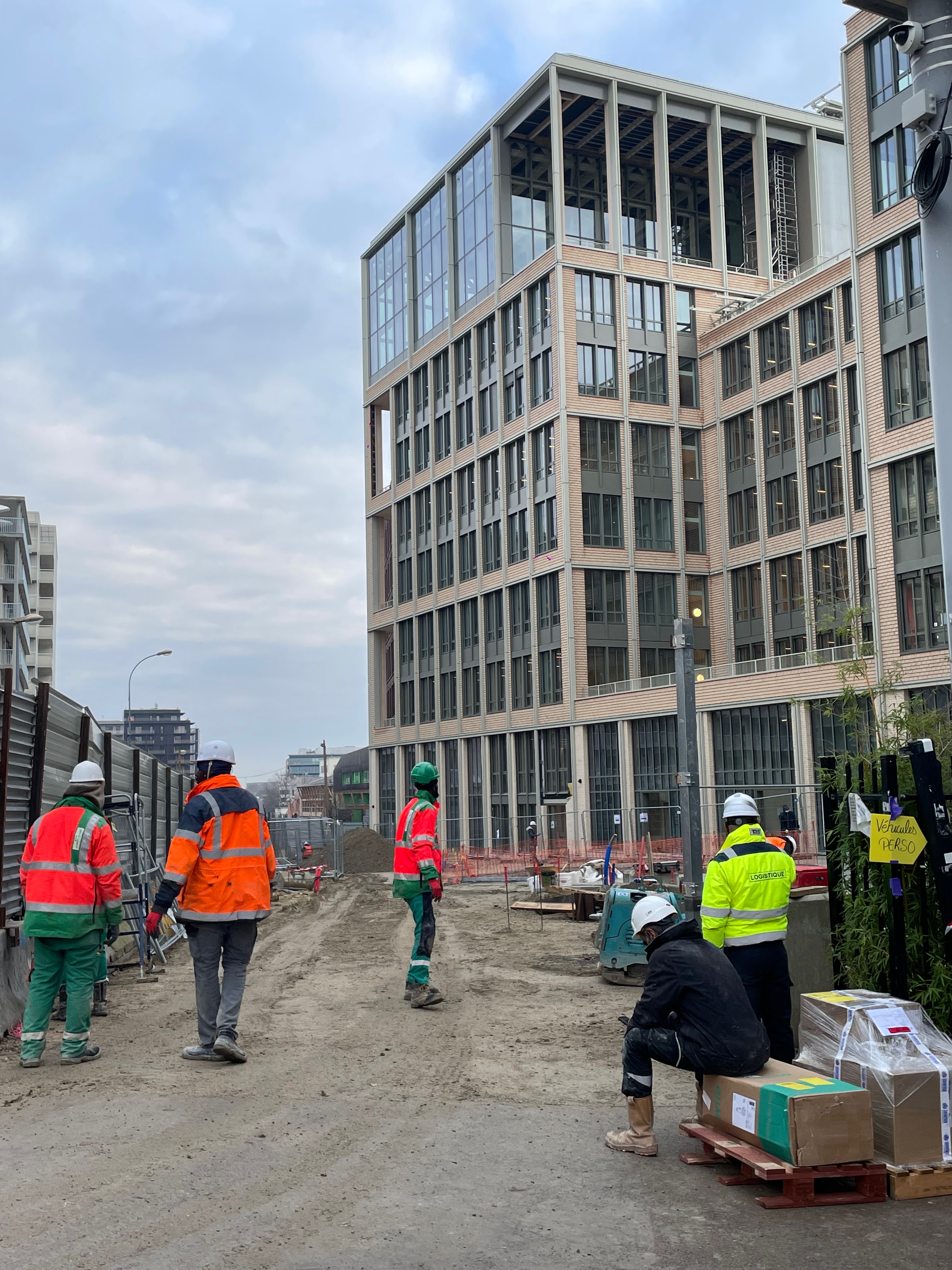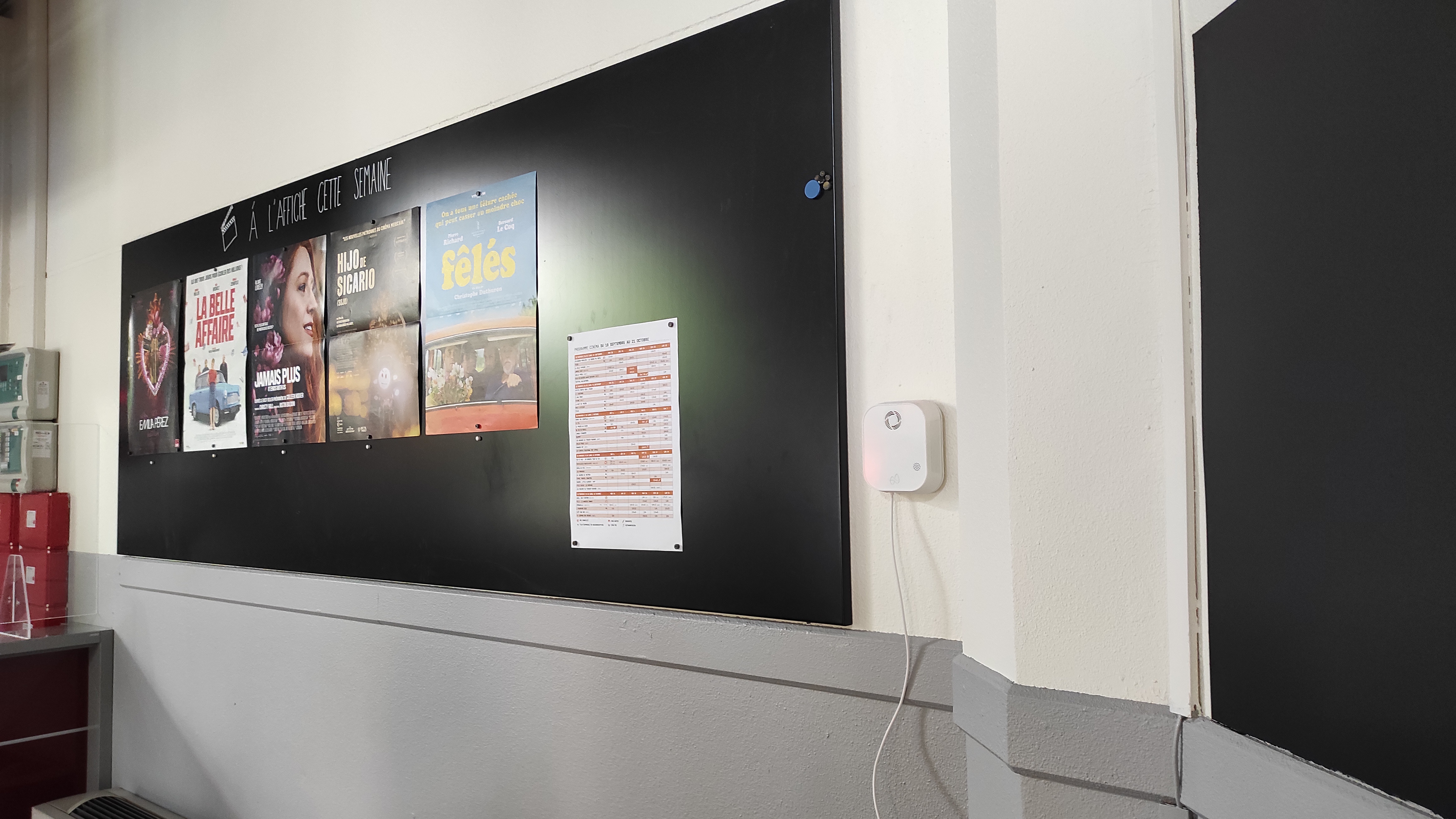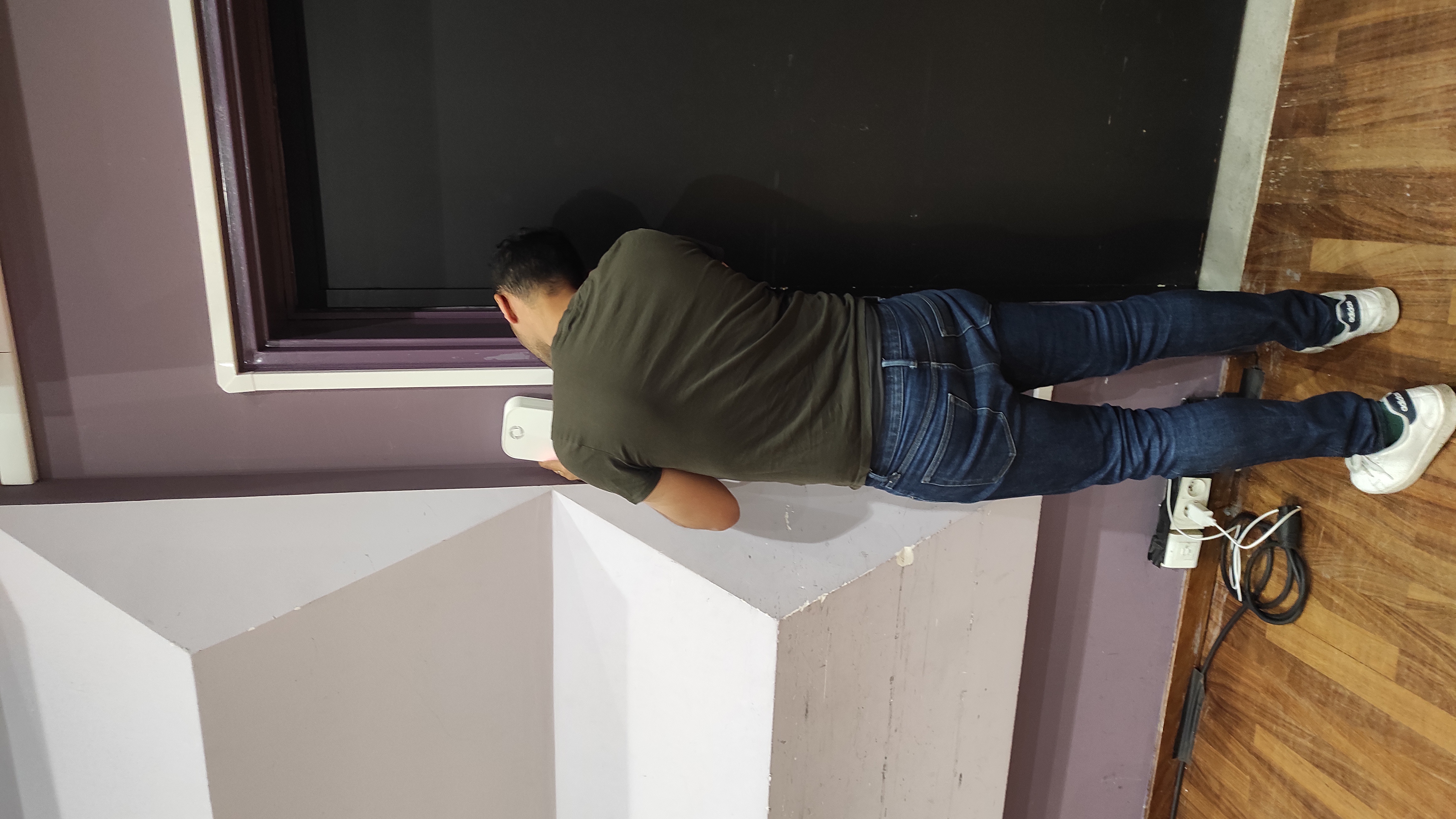Prioritising the places and people that need it the most
Olympic Innovation for Green Cities
From Olympic Innovation to Local Legacy: Smart Air & Energy Solutions for Sustainable Cities
From Olympic Innovation to Local Impact: Istya’s smart air and energy solutions, first deployed at the Olympic Village, now enhance urban sustainability. By optimizing HVAC systems and improving air quality, our technology reduces CO₂ emissions and energy costs, bringing healthier environments to cities like Aulnay-sous-Bois. A scalable model for Europe, turning world-class innovation into a lasting local legacy.
France
Local
City of Saint-Denis - France
Mainly urban
It refers to a physical transformation of the built environment (hard investment)
Yes
2024-09-21
No
No
Yes
Yes
Yes
As a representative of an organisation
This project includes the deployment of Istya’s technology for clean air and energy efficiency in the Olympic Village, showcasing European leadership on the global stage while ensuring a long-term sustainability legacy. The heritage phase of the project extends beyond the Games by transferring Istya’s Olympic Village technology to support the site’s new mission, as it is repurposed into permanent housing and office spaces. However, we chose to go further working toward climate justice and urban sustainability by freely providing our technology to Aulnay-sous-Bois, a city that would not typically have access to such advanced environmental solutions
The project democratizes access to high-tech sustainability innovations, ensuring that cutting-edge technology remains in use beyond the event and reaches underserved communities
The project has already delivered real-world results:
At the Olympic Village in Seine-Saint-Denis, an underserved community, Istya’s AI-driven system has reduced energy consumption and improved air quality in newly converted housing and offices, proving its effectiveness in large-scale, mixed-use developments.
In Aulnay-sous-Bois, AI-powered air quality monitoring has been deployed, providing municipal authorities with real-time environmental insights to improve air management in public buildings and community centers.
Additionally, the project goes beyond standard technology transfers by ensuring these advanced tools are freely accessible, reinforcing our commitment to climate justice and inclusive urban transformation
To expand this impact, Istya has partnered with the Métropole du Grand Paris, which is supporting efforts to scale the project to other cities
By linking post-Olympic transformation with long-term technological accessibility, this project sets a new standard for sustainability legacies, proving that high-performance environmental solutions should serve not just global events but also communities that need them most
The project democratizes access to high-tech sustainability innovations, ensuring that cutting-edge technology remains in use beyond the event and reaches underserved communities
The project has already delivered real-world results:
At the Olympic Village in Seine-Saint-Denis, an underserved community, Istya’s AI-driven system has reduced energy consumption and improved air quality in newly converted housing and offices, proving its effectiveness in large-scale, mixed-use developments.
In Aulnay-sous-Bois, AI-powered air quality monitoring has been deployed, providing municipal authorities with real-time environmental insights to improve air management in public buildings and community centers.
Additionally, the project goes beyond standard technology transfers by ensuring these advanced tools are freely accessible, reinforcing our commitment to climate justice and inclusive urban transformation
To expand this impact, Istya has partnered with the Métropole du Grand Paris, which is supporting efforts to scale the project to other cities
By linking post-Olympic transformation with long-term technological accessibility, this project sets a new standard for sustainability legacies, proving that high-performance environmental solutions should serve not just global events but also communities that need them most
Sustainability
Air Quality
Energy Efficiency
Urban Innovation
Climate Justice
The project enhances urban sustainability by optimizing energy use and improving air quality in both high-performance and underserved environments. By leveraging AI-driven technology from the Olympic Village and ensuring its long-term impact through municipal adoption, it demonstrates how advanced sustainability solutions can benefit a wider range of communities.
A key objective is reducing energy consumption and carbon emissions. AI-driven optimization has already cut energy use and significantly reduced CO₂ emissions in the Olympic Village. This contributes directly to climate goals by making urban energy systems more efficient and reducing environmental impact.
Another focus is improving urban air quality. Through predictive monitoring and intelligent HVAC management, the project creates healthier indoor environments. By reducing pollutants that affect public health, it addresses major urban challenges related to respiratory diseases and environmental well-being.
The project also promotes circular urban development by ensuring that sustainability technologies from the Olympic Village remain in use beyond the event. Instead of being a temporary intervention, these innovations are integrated into municipal infrastructure, creating a long-term legacy with lasting environmental and economic benefits.
It further strengthens climate resilience by equipping local governments with data-driven tools to manage climate challenges like heat waves and poor air quality. The expansion to Aulnay-sous-Bois and future scalability demonstrate how municipalities can adopt advanced sustainability strategies even with limited resources.
By providing AI-powered air and energy management tools freely to underserved cities, the project ensures equitable access to sustainability technologies. It proves that innovations developed for elite global events can transition into scalable, inclusive urban solutions, making climate action accessible to all communities
A key objective is reducing energy consumption and carbon emissions. AI-driven optimization has already cut energy use and significantly reduced CO₂ emissions in the Olympic Village. This contributes directly to climate goals by making urban energy systems more efficient and reducing environmental impact.
Another focus is improving urban air quality. Through predictive monitoring and intelligent HVAC management, the project creates healthier indoor environments. By reducing pollutants that affect public health, it addresses major urban challenges related to respiratory diseases and environmental well-being.
The project also promotes circular urban development by ensuring that sustainability technologies from the Olympic Village remain in use beyond the event. Instead of being a temporary intervention, these innovations are integrated into municipal infrastructure, creating a long-term legacy with lasting environmental and economic benefits.
It further strengthens climate resilience by equipping local governments with data-driven tools to manage climate challenges like heat waves and poor air quality. The expansion to Aulnay-sous-Bois and future scalability demonstrate how municipalities can adopt advanced sustainability strategies even with limited resources.
By providing AI-powered air and energy management tools freely to underserved cities, the project ensures equitable access to sustainability technologies. It proves that innovations developed for elite global events can transition into scalable, inclusive urban solutions, making climate action accessible to all communities
This project places design at the heart of its approach, ensuring that sustainability, air quality, and energy efficiency are seamlessly integrated into the built environment without compromising aesthetics or user experience. By adapting the design of its solutions to different contexts from the Olympic Village to Aulnay-sous-Bois the project exemplifies how functional innovation can enhance urban spaces while respecting architectural intent.
At the Olympic Village, the design approach was highly collaborative, working closely with architects to ensure that the air quality monitoring and optimization systems complemented the existing material choices and visual identity.
In Aulnay-sous-Bois, the design took on a more bold and reflective aesthetic, embracing a modern and innovative visual language. This shift acknowledges the need to create a stronger presence for air quality and energy efficiency solutions in public spaces, helping to raise awareness of their importance. The more visible and contemporary design choices reinforce the idea that sustainability should be an integral part of urban environments, not an afterthought
Beyond physical integration, the project also focused on user experience in the digital platform, ensuring that air quality and energy efficiency data are easily understandable by all users. This was particularly important in municipal environments, where there are often no dedicated air quality experts. By making complex environmental data accessible through an intuitive interface, the platform empowers decision-makers, facility managers, and citizens to engage with sustainability in a meaningful way
The design of our solution was improved as part of the NEB Catalyst program, with the support of experts, ensuring that it is deeply embedded in the values of the NEB. By blending aesthetics, functionality, and accessibility, the project sets a new standard for how technology can support well-being while remaining visually harmonious
At the Olympic Village, the design approach was highly collaborative, working closely with architects to ensure that the air quality monitoring and optimization systems complemented the existing material choices and visual identity.
In Aulnay-sous-Bois, the design took on a more bold and reflective aesthetic, embracing a modern and innovative visual language. This shift acknowledges the need to create a stronger presence for air quality and energy efficiency solutions in public spaces, helping to raise awareness of their importance. The more visible and contemporary design choices reinforce the idea that sustainability should be an integral part of urban environments, not an afterthought
Beyond physical integration, the project also focused on user experience in the digital platform, ensuring that air quality and energy efficiency data are easily understandable by all users. This was particularly important in municipal environments, where there are often no dedicated air quality experts. By making complex environmental data accessible through an intuitive interface, the platform empowers decision-makers, facility managers, and citizens to engage with sustainability in a meaningful way
The design of our solution was improved as part of the NEB Catalyst program, with the support of experts, ensuring that it is deeply embedded in the values of the NEB. By blending aesthetics, functionality, and accessibility, the project sets a new standard for how technology can support well-being while remaining visually harmonious
This project prioritizes inclusion by ensuring that advanced air quality and energy efficiency solutions are accessible, affordable, and understandable for all, regardless of expertise or location. By integrating a design-for-all approach, engaging municipalities with limited resources, and making data actionable, it sets a new standard for equitable urban innovation
A key objective is to ensure accessibility and affordability, particularly for municipalities and communities that are often left behind in technological advancements. The project was designed to be cost-efficient and easily deployable, allowing cities like Aulnay-sous-Bois, which traditionally lack access to cutting-edge sustainability solutions, to implement a system previously reserved for high-profile locations such as the Olympic Village. Deployed in public offices and municipal buildings, the project directly benefits citizens, particularly those in underserved communities who rely on public infrastructure
Another critical objective is simplifying complex environmental data to make air quality and energy efficiency understandable to all. The digital platform was designed with an inclusive user experience (UX) ensuring that municipal staff, facility managers, and decision-makers without air quality expertise can easily interpret and act upon the data. This removes technical barriers that often exclude smaller cities from implementing sustainability measures, making climate action more democratic and participatory
The project also supports inclusive governance by enabling municipalities to take ownership of their air quality and energy management without requiring external specialists. This shifts the power dynamics of urban sustainability, allowing local governments to make data-driven decisions that directly impact public health and energy costs
It demonstrates that sustainability and clean air are not privileges for major cities, but fundamental rights that should be accessible to all
A key objective is to ensure accessibility and affordability, particularly for municipalities and communities that are often left behind in technological advancements. The project was designed to be cost-efficient and easily deployable, allowing cities like Aulnay-sous-Bois, which traditionally lack access to cutting-edge sustainability solutions, to implement a system previously reserved for high-profile locations such as the Olympic Village. Deployed in public offices and municipal buildings, the project directly benefits citizens, particularly those in underserved communities who rely on public infrastructure
Another critical objective is simplifying complex environmental data to make air quality and energy efficiency understandable to all. The digital platform was designed with an inclusive user experience (UX) ensuring that municipal staff, facility managers, and decision-makers without air quality expertise can easily interpret and act upon the data. This removes technical barriers that often exclude smaller cities from implementing sustainability measures, making climate action more democratic and participatory
The project also supports inclusive governance by enabling municipalities to take ownership of their air quality and energy management without requiring external specialists. This shifts the power dynamics of urban sustainability, allowing local governments to make data-driven decisions that directly impact public health and energy costs
It demonstrates that sustainability and clean air are not privileges for major cities, but fundamental rights that should be accessible to all
This project was designed with a collaborative approach, ensuring that air quality and energy efficiency improvements directly respond to the needs of municipal authorities, building occupants, and local stakeholders. By working closely with public sector decision-makers, facility managers, and those who use these spaces daily, the project ensures practical, effective, and user-centered implementation.
In Aulnay-sous-Bois, the project engaged municipal authorities to ensure alignment with local sustainability and energy efficiency goals. Collaboration with building operators and facility managers allowed for seamless integration of the system within municipal buildings, where air quality is a critical factor in daily operations.
Building occupants, including public employees were also involved in the process. By working with these groups, the project was able to optimize sensor placement, adjust monitoring parameters, and ensure that air quality insights were clear and actionable.
The digital platform served as a key tool for participation, providing real-time air quality insights to municipal staff and building managers. The accessibility of this data enabled informed decision-making at the local level, ensuring that air quality improvements were not just implemented but also actively monitored and adapted based on real-world usage and feedback.
This approach strengthened local governance capabilities, allowing municipalities to take ownership of sustainability improvements rather than relying solely on external experts. The result is a project that does not impose a pre-designed solution, but instead co-develops it with the stakeholders who use and manage public buildings daily.
It proves that sustainability solutions are most effective when they are tailored through direct collaboration with those who will use them, ensuring long-term impact and community-driven adoption.
In Aulnay-sous-Bois, the project engaged municipal authorities to ensure alignment with local sustainability and energy efficiency goals. Collaboration with building operators and facility managers allowed for seamless integration of the system within municipal buildings, where air quality is a critical factor in daily operations.
Building occupants, including public employees were also involved in the process. By working with these groups, the project was able to optimize sensor placement, adjust monitoring parameters, and ensure that air quality insights were clear and actionable.
The digital platform served as a key tool for participation, providing real-time air quality insights to municipal staff and building managers. The accessibility of this data enabled informed decision-making at the local level, ensuring that air quality improvements were not just implemented but also actively monitored and adapted based on real-world usage and feedback.
This approach strengthened local governance capabilities, allowing municipalities to take ownership of sustainability improvements rather than relying solely on external experts. The result is a project that does not impose a pre-designed solution, but instead co-develops it with the stakeholders who use and manage public buildings daily.
It proves that sustainability solutions are most effective when they are tailored through direct collaboration with those who will use them, ensuring long-term impact and community-driven adoption.
This project was developed through multi-level stakeholder engagement, ensuring that local, regional, national, and European actors played a key role in its design, implementation, and scalability. Each level contributed expertise, resources, and institutional support, reinforcing the project's replicability and long-term impact.
At the local level, the project collaborated with municipal authorities in Aulnay-sous-Bois, who defined priorities for air quality and energy efficiency improvements. Facility managers and public building operators played a critical role in deploying the air quality monitoring system, ensuring it was adapted to real-world infrastructure needs. Building occupants and public employees provided feedback that helped refine sensor placement and system design, improving usability and effectiveness.
At the Paris metropolitan level, urban sustainability stakeholders integrated the project into broader climate adaptation strategies, aligning it with existing frameworks to make it a scalable model for other municipalities. Policymakers provided insights on regulatory considerations and regional expansion, reinforcing its long-term urban planning goals.
At the national level, the project aligned with France’s urban climate policies, benefiting from regulatory incentives supporting energy-efficient municipal infrastructure.
At the European level, the project was shaped by the New European Bauhaus (NEB) Catalyst program, which provided guidance on sustainable design and urban innovation. This collaboration enhanced the project’s data accessibility tools, making air quality insights more actionable for municipal decision-makers.
This co-development approach ensured that the project was tailored to stakeholder needs, making it effective, scalable, and deeply embedded in sustainability policies.
At the local level, the project collaborated with municipal authorities in Aulnay-sous-Bois, who defined priorities for air quality and energy efficiency improvements. Facility managers and public building operators played a critical role in deploying the air quality monitoring system, ensuring it was adapted to real-world infrastructure needs. Building occupants and public employees provided feedback that helped refine sensor placement and system design, improving usability and effectiveness.
At the Paris metropolitan level, urban sustainability stakeholders integrated the project into broader climate adaptation strategies, aligning it with existing frameworks to make it a scalable model for other municipalities. Policymakers provided insights on regulatory considerations and regional expansion, reinforcing its long-term urban planning goals.
At the national level, the project aligned with France’s urban climate policies, benefiting from regulatory incentives supporting energy-efficient municipal infrastructure.
At the European level, the project was shaped by the New European Bauhaus (NEB) Catalyst program, which provided guidance on sustainable design and urban innovation. This collaboration enhanced the project’s data accessibility tools, making air quality insights more actionable for municipal decision-makers.
This co-development approach ensured that the project was tailored to stakeholder needs, making it effective, scalable, and deeply embedded in sustainability policies.
This project was developed through a multidisciplinary approach, integrating artificial intelligence, HVAC engineering, energy efficiency, design, and municipal governance. This collaboration ensured that the system was not only technologically advanced but also practical, user-friendly, and tailored to public sector needs
The artificial intelligence team developed AI-driven predictive models that optimize HVAC systems in real time. Working closely with HVAC engineers, they calibrated these models to reduce energy consumption and maintain optimal indoor air quality, dynamically adjusting based on occupancy and environmental conditions. This system was successfully deployed at the Olympic Village, where it demonstrated significant energy savings and air quality improvements
The energy efficiency experts analyzed the interaction between air circulation, ventilation efficiency, and energy consumption, ensuring that the system improved air quality while optimizing energy use. Their insights guided sensor placement strategies, maximizing impact in high-occupancy public buildings, reinforcing the project’s sustainability impact
The design team played a crucial role in making complex air quality data accessible to non-experts. A generative AI component within the digital platform automates action plans and reports, enabling municipal decision-makers to interpret insights and take action without specialized training.
Municipal governance and policy experts ensured the project aligned with local regulations and climate policies, making adoption seamless for municipalities. Their engagement also helped streamline regulatory approval, ensuring smoother integration into public infrastructure and energy efficiency frameworks
Collaboration was reinforced through technical workshops, pilot testing, and continuous feedback loops, ensuring adaptation based on real-world use. This approach bridged the gap between advanced technology and practical urban implementation
The artificial intelligence team developed AI-driven predictive models that optimize HVAC systems in real time. Working closely with HVAC engineers, they calibrated these models to reduce energy consumption and maintain optimal indoor air quality, dynamically adjusting based on occupancy and environmental conditions. This system was successfully deployed at the Olympic Village, where it demonstrated significant energy savings and air quality improvements
The energy efficiency experts analyzed the interaction between air circulation, ventilation efficiency, and energy consumption, ensuring that the system improved air quality while optimizing energy use. Their insights guided sensor placement strategies, maximizing impact in high-occupancy public buildings, reinforcing the project’s sustainability impact
The design team played a crucial role in making complex air quality data accessible to non-experts. A generative AI component within the digital platform automates action plans and reports, enabling municipal decision-makers to interpret insights and take action without specialized training.
Municipal governance and policy experts ensured the project aligned with local regulations and climate policies, making adoption seamless for municipalities. Their engagement also helped streamline regulatory approval, ensuring smoother integration into public infrastructure and energy efficiency frameworks
Collaboration was reinforced through technical workshops, pilot testing, and continuous feedback loops, ensuring adaptation based on real-world use. This approach bridged the gap between advanced technology and practical urban implementation
This project transforms high-performance air quality and energy optimization technology from the Olympic Village into a scalable, long-term urban solution. Unlike conventional systems that rely on fixed schedules, this project integrates AI-driven predictive optimization, creating a self-learning, adaptable tool for municipalities.
Traditional air quality monitoring and HVAC systems often operate on static schedules, leading to energy waste and inconsistent air quality control. This project replaces outdated models with AI-powered real-time adjustments, dynamically optimizing ventilation, heating, and cooling based on actual and future air quality. The system has demonstrated up to 40% energy savings while improving indoor air quality, surpassing traditional methods in both efficiency and sustainability.
A major innovation is the integration of generative AI within the digital platform, which automates air quality analysis, energy efficiency recommendations, and report generation. Unlike conventional systems requiring manual data interpretation, this AI-powered tool translates complex data into actionable insights, enabling municipal facility managers to make informed decisions without specialized expertise.
What sets this project apart is its legacy-driven approach. While most smart air and energy solutions are developed for individual buildings, this project proves that technology initially deployed for a large-scale event can transition into long-term public infrastructure. The expansion from the Olympic Village to Aulnay-sous-Bois ensures that cutting-edge sustainability solutions extend beyond high-profile events to benefit underserved communities.
By transforming a temporary Olympic innovation into a lasting urban model, this project sets a new standard for municipalities, proving that advanced sustainability solutions can be replicated and adapted across diverse urban environments, making energy efficiency and air quality management more inclusive
Traditional air quality monitoring and HVAC systems often operate on static schedules, leading to energy waste and inconsistent air quality control. This project replaces outdated models with AI-powered real-time adjustments, dynamically optimizing ventilation, heating, and cooling based on actual and future air quality. The system has demonstrated up to 40% energy savings while improving indoor air quality, surpassing traditional methods in both efficiency and sustainability.
A major innovation is the integration of generative AI within the digital platform, which automates air quality analysis, energy efficiency recommendations, and report generation. Unlike conventional systems requiring manual data interpretation, this AI-powered tool translates complex data into actionable insights, enabling municipal facility managers to make informed decisions without specialized expertise.
What sets this project apart is its legacy-driven approach. While most smart air and energy solutions are developed for individual buildings, this project proves that technology initially deployed for a large-scale event can transition into long-term public infrastructure. The expansion from the Olympic Village to Aulnay-sous-Bois ensures that cutting-edge sustainability solutions extend beyond high-profile events to benefit underserved communities.
By transforming a temporary Olympic innovation into a lasting urban model, this project sets a new standard for municipalities, proving that advanced sustainability solutions can be replicated and adapted across diverse urban environments, making energy efficiency and air quality management more inclusive
The project follows a structured multi-phase methodology to ensure effective deployment, real-world adaptability, and long-term scalability. This approach enables the transition of AI-powered air quality and energy monitoring solutions from the Olympic Village to municipal settings, ensuring that advanced sustainability technology benefits local communities.
The first phase involved data collection and AI model development. At the Olympic Village, real-time air quality data were collected from high-performance buildings to train AI-driven predictive models. This phase focused on analyzing ventilation, heating, and cooling systems to improve efficiency while maintaining optimal indoor air quality.
The second phase focused on technology adaptation and municipal integration. Unlike the controlled environment of the Olympic Village, municipal buildings in Aulnay-sous-Bois operate with different infrastructure constraints. AI-powered air quality monitoring was adapted to the specific environmental and occupancy conditions of public buildings. The focus was on providing real-time air quality and energy efficiency insights rather than automating controls, ensuring that municipal authorities could make data-driven decisions to improve indoor environments.
The third phase emphasized usability and accessibility for decision-makers. A generative AI-powered digital platform was developed to automate air quality and energy analysis, reports, and recommendations, making complex data actionable for non-expert municipal staff. This ensures that building managers can understand trends and take appropriate action based on real-time insights.
The final phase focuses on collaboration with the Métropole du Grand Paris to ensure that the project serves as a scalable model for other cities, demonstrating how AI-powered air quality monitoring can enhance urban resilience across Europe.
The first phase involved data collection and AI model development. At the Olympic Village, real-time air quality data were collected from high-performance buildings to train AI-driven predictive models. This phase focused on analyzing ventilation, heating, and cooling systems to improve efficiency while maintaining optimal indoor air quality.
The second phase focused on technology adaptation and municipal integration. Unlike the controlled environment of the Olympic Village, municipal buildings in Aulnay-sous-Bois operate with different infrastructure constraints. AI-powered air quality monitoring was adapted to the specific environmental and occupancy conditions of public buildings. The focus was on providing real-time air quality and energy efficiency insights rather than automating controls, ensuring that municipal authorities could make data-driven decisions to improve indoor environments.
The third phase emphasized usability and accessibility for decision-makers. A generative AI-powered digital platform was developed to automate air quality and energy analysis, reports, and recommendations, making complex data actionable for non-expert municipal staff. This ensures that building managers can understand trends and take appropriate action based on real-time insights.
The final phase focuses on collaboration with the Métropole du Grand Paris to ensure that the project serves as a scalable model for other cities, demonstrating how AI-powered air quality monitoring can enhance urban resilience across Europe.
This project was designed to be highly replicable and adaptable, ensuring that its technology, methodology, and insights can be transferred to different urban contexts, public infrastructures, and beneficiary groups. Its transition from the Olympic Village to Aulnay-sous-Bois demonstrates its scalability and applicability in diverse municipal settings.
The air quality monitoring system can be deployed in public buildings, schools, hospitals, and offices, allowing municipalities and facility managers to monitor real-time air quality trends and make informed decisions. Since the system is non-proprietary, it integrates with various infrastructures, making it scalable for cities with different budgets and technical capabilities. While automation is not included in this legacy phase, it can be easily added by integrating with a BMS or with an additional microcomputer in the building, Istya AI can function as a BMS, optimizing ventilation and energy use, potentially saving cities hundreds of euros annually.
The generative AI-powered digital platform is also easily replicable. By automating data interpretation, reports, and recommendations, it ensures that non-expert users can access actionable insights. This reduces reliance on external consultants and empowers municipalities.
The methodology used in Aulnay-sous-Bois can be applied to other European cities, particularly those with aging public buildings lacking environmental monitoring systems. The step-by-step process, from data collection and adaptation to municipal integration and continuous monitoring, can support climate adaptation efforts across different urban contexts
Additionally, the collaborative governance model, involving municipal authorities, technical experts, and policymakers, provides a framework for effective policy integration and long-term sustainability. The project's expansion with the Métropole du Grand Paris further strengthens its potential as a blueprint for sustainable EU projects
The air quality monitoring system can be deployed in public buildings, schools, hospitals, and offices, allowing municipalities and facility managers to monitor real-time air quality trends and make informed decisions. Since the system is non-proprietary, it integrates with various infrastructures, making it scalable for cities with different budgets and technical capabilities. While automation is not included in this legacy phase, it can be easily added by integrating with a BMS or with an additional microcomputer in the building, Istya AI can function as a BMS, optimizing ventilation and energy use, potentially saving cities hundreds of euros annually.
The generative AI-powered digital platform is also easily replicable. By automating data interpretation, reports, and recommendations, it ensures that non-expert users can access actionable insights. This reduces reliance on external consultants and empowers municipalities.
The methodology used in Aulnay-sous-Bois can be applied to other European cities, particularly those with aging public buildings lacking environmental monitoring systems. The step-by-step process, from data collection and adaptation to municipal integration and continuous monitoring, can support climate adaptation efforts across different urban contexts
Additionally, the collaborative governance model, involving municipal authorities, technical experts, and policymakers, provides a framework for effective policy integration and long-term sustainability. The project's expansion with the Métropole du Grand Paris further strengthens its potential as a blueprint for sustainable EU projects
This project addresses critical global challenges related to climate change, urban air pollution, energy efficiency, and environmental inequality by implementing scalable local solutions in municipal settings. By transitioning Olympic-grade air quality management technology to underserved communities, the project ensures that advanced sustainability innovations are accessible beyond elite environments.
One of the major challenges it tackles is urban air pollution, which causes more than 8 million deaths annually and contributes to respiratory diseases and reduced life expectancy worldwide. Many cities lack indoor air quality monitoring, preventing proactive action. This project provides AI-powered air quality insights to municipalities, allowing them to identify pollution trends, optimize ventilation strategies, and implement targeted interventions to improve public health
The project also addresses energy inefficiency in public buildings, a key contributor to global CO₂ emissions. While most sustainability efforts focus on new, high-tech buildings, many cities struggle with aging infrastructure lacking smart energy solutions. This project offers a scalable, non-proprietary system that can be integrated with existing municipal buildings, ensuring that air quality improvements do not come at the cost of increased energy consumption.
Another key issue is climate resilience and environmental justice. Low-income and underserved communities often face worse air quality and receive less investment in sustainability technologies. By deploying free air quality monitoring solutions in Aulnay-sous-Bois, the project ensures that environmental innovations benefit those who need them most
By providing an accessible, scalable model for air quality and environmental monitoring, this project serves as a template for other cities worldwide, proving that cutting-edge climate solutions can be adapted to real-world municipal needs, driving global impact through local action
One of the major challenges it tackles is urban air pollution, which causes more than 8 million deaths annually and contributes to respiratory diseases and reduced life expectancy worldwide. Many cities lack indoor air quality monitoring, preventing proactive action. This project provides AI-powered air quality insights to municipalities, allowing them to identify pollution trends, optimize ventilation strategies, and implement targeted interventions to improve public health
The project also addresses energy inefficiency in public buildings, a key contributor to global CO₂ emissions. While most sustainability efforts focus on new, high-tech buildings, many cities struggle with aging infrastructure lacking smart energy solutions. This project offers a scalable, non-proprietary system that can be integrated with existing municipal buildings, ensuring that air quality improvements do not come at the cost of increased energy consumption.
Another key issue is climate resilience and environmental justice. Low-income and underserved communities often face worse air quality and receive less investment in sustainability technologies. By deploying free air quality monitoring solutions in Aulnay-sous-Bois, the project ensures that environmental innovations benefit those who need them most
By providing an accessible, scalable model for air quality and environmental monitoring, this project serves as a template for other cities worldwide, proving that cutting-edge climate solutions can be adapted to real-world municipal needs, driving global impact through local action
This project has delivered measurable improvements in air quality monitoring, sustainability awareness, and municipal decision-making, ensuring that advanced environmental technology benefits both direct and indirect stakeholders.
At the Olympic Village, the deployment of AI-powered air quality monitoring and energy optimization demonstrated significant reductions in energy consumption and improvements in indoor air quality. The system provided real-time environmental insights, helping to optimize ventilation strategies while maintaining energy efficiency.
In Aulnay-sous-Bois, the project has successfully integrated air quality monitoring into municipal buildings, providing real-time data that enables city officials to track pollution levels and take informed actions. While automation was not included in this phase, the system allows municipal decision-makers to anticipate air quality issues and implement targeted interventions.
The direct beneficiaries include municipal authorities, facility managers, and public sector employees, who now have access to accurate air quality insights, enabling better resource management and policy decisions. The system has also empowered schools and public buildings to create healthier indoor environments, improving well-being for students, teachers, and employees.
Indirect beneficiaries include residents and urban communities, who benefit from long-term improvements in air quality, reduced energy consumption, and enhanced environmental policies. The data-driven approach has also raised public awareness of air quality issues, encouraging broader discussions on sustainability and public health.
By providing a scalable and transferable model, the project demonstrates how AI-powered environmental monitoring can be expanded to other cities, reinforcing its long-term impact on urban sustainability and climate resilience.
At the Olympic Village, the deployment of AI-powered air quality monitoring and energy optimization demonstrated significant reductions in energy consumption and improvements in indoor air quality. The system provided real-time environmental insights, helping to optimize ventilation strategies while maintaining energy efficiency.
In Aulnay-sous-Bois, the project has successfully integrated air quality monitoring into municipal buildings, providing real-time data that enables city officials to track pollution levels and take informed actions. While automation was not included in this phase, the system allows municipal decision-makers to anticipate air quality issues and implement targeted interventions.
The direct beneficiaries include municipal authorities, facility managers, and public sector employees, who now have access to accurate air quality insights, enabling better resource management and policy decisions. The system has also empowered schools and public buildings to create healthier indoor environments, improving well-being for students, teachers, and employees.
Indirect beneficiaries include residents and urban communities, who benefit from long-term improvements in air quality, reduced energy consumption, and enhanced environmental policies. The data-driven approach has also raised public awareness of air quality issues, encouraging broader discussions on sustainability and public health.
By providing a scalable and transferable model, the project demonstrates how AI-powered environmental monitoring can be expanded to other cities, reinforcing its long-term impact on urban sustainability and climate resilience.






